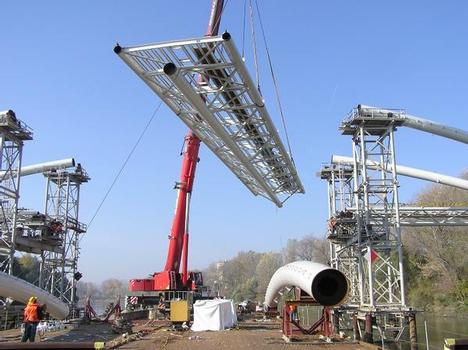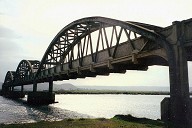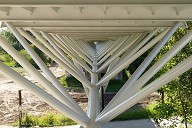Winged crossing
The construction of a new bridge for cyclists and pedestrians over the River Tisza in Hungary was completed by the end of last year. Tiszavirág Bridge creates a new link in the city of Szolnok, some 90 km east of Budapest. It provides a direct route from the city centre on the north side of the river to the recreational area on the south. The name Tiszavirág has two meanings in Hungarian: "mayfly” and "flower of Tisza river” – and the bridge is intended to symbolize both.
The project began in 2007 with a design competition which was won by a local team comprised of structural engineer Pont-TERV and architect ADU. The winning concept was a slim, elegant, splayed arch that was intended to combine a dramatic visual impact with good functionality and economic construction.
The steel arch bridge has a main span of 120 m made up of two tubular arches, splayed outwards so that each forms an angle of 60° with the horizontal, and a truss girder deck suspended from tie rods. The deck girder is 5 m wide and 2 m deep, and is also formed of tubular steel elements: a main spine beam along the bottom, two upper edge beams and two inclined trusses connecting them. The deck consists of a steel grid covered with wood-resin composite planks. As well as the main river span, the bridge has steel truss approach spans over the flood plain and reinforced concrete approach bridges on each side, making a total length of 450 m. The adjoining structure includes ramps for cyclists, stairs for pedestrians and elevators to make the bridge fully accessible. The lighting design uses LED technology: on the outside of each arch there is a dotted line of lamps, and a light beam illuminates the inner edge. Illumination of the deck is provided by LED lights in the handrails and the deck also has built-in glass panels to allow a view of the illuminated structure.
Main contractor KÖZGÉP, one of Hungary’s largest steel contractors, began construction work in 2009. The bridge superstructure was fabricated in 30 m long units and transported by barge from Budapest to Szolnok via the Danube and Tisza rivers. Site erection followed on two auxiliary supports in the river and construction required high precision in order to achieve the correct geometry of the structure. The bridge has been open to traffic since December 2010; progress was delayed by severe flooding of the River Tisza. The client for the project is the Municipality of Szolnok.
References
Structure Types
- About this
data sheet - Product-ID
6282 - Published on:
22/05/2013 - Last updated on:
15/03/2022







